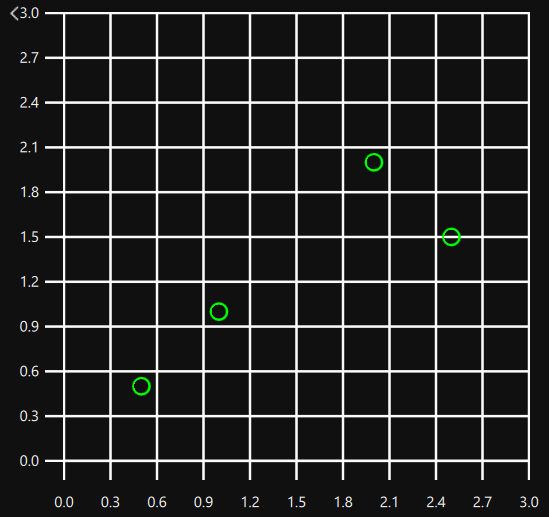
The ScatterSeries type presents data in scatter graphs. More...
| Import Statement: | import QtGraphs |
| In C++: | QScatterSeries |
| Inherits: |
The scatter data is displayed as a collection of points on the graph. For each point, two values are specified that determine its position on the horizontal axis and the vertical axis.

You can represent scatter data by creating a ScatterSeries inside GraphsView. The data can be added to the graph by creating XYPoints as children for the ScatterSeries that define the x and y values of each point.
GraphsView { anchors.fill: parent axisX: ValueAxis { max: 3 } axisY: ValueAxis { max: 3 } ScatterSeries { color: "#00ff00" XYPoint { x: 0.5; y: 0.5 } XYPoint { x: 1; y: 1 } XYPoint { x: 2; y: 2 } XYPoint { x: 2.5; y: 1.5 } } }
Multiple scatter graphs can be created by adding multiple ScatterSeries as children of GraphsView. In such cases only one series should define the axis used as multiple definitions only override the earlier ones.
GraphsView { anchors.fill: parent ScatterSeries { color: "#00ff00" axisX: ValueAxis { max: 3 } axisY: ValueAxis { max: 3 } XYPoint { x: 0.5; y: 0.5 } XYPoint { x: 1; y: 1 } XYPoint { x: 2; y: 2 } XYPoint { x: 2.5; y: 1.5 } } ScatterSeries { color: "#ff0000" XYPoint { x: 0.5; y: 3 } XYPoint { x: 1; y: 2 } XYPoint { x: 2; y: 2.5 } XYPoint { x: 2.5; y: 1 } } }
|
pointDelegate : Component |
Marks points with the given QML component.
pointDelegate: Image {
source: "images/happy_box.png"
}

As part of the free Business evaluation, we offer a free welcome call for companies, to talk about your requirements, and how the Felgo SDK & Services can help you. Just sign up and schedule your call.
Sign up now to start your free Business evaluation:

